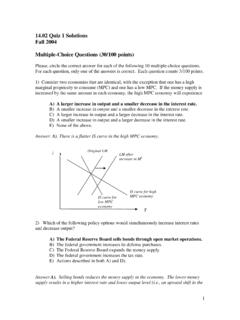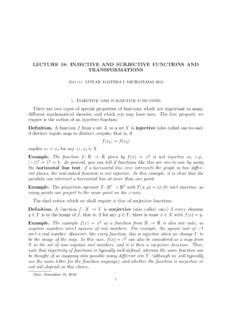Transcription of Challenge Problem Solutions: Static Equilibrium
1 Static Equilibrium Challenge Problem solutions Problem 1: Static Equilibrium : Steel Beam and Cable A uniform steel beam of mass m1= !10 2 kg is held up by a steel cable that is connected to the beam a distance L = m from the wall, at an angle ! = 30 ! as shown ! in the sketch. The beam is bolted to the wall with an unknown force F exerted by the 1wall on the beam. An object of mass m2 = !10 kg, resting on top of the beam, is placed a distance d = m from the wall. Use g = m s "!2for the gravitational acceleration. a) Draw a free-body diagram for the beam.
2 B) Find equations for Static Equilibrium for the beam (this will involve force equations and torque relations). c) Find the tension in the cable. d) Find the horizontal and vertical components of the force that the wall exerts on the beam. Problem 1 Solution: (a) Free-body diagram for the beam: ! Td Fx O ! ! L/2 F m2gFy m1g L ! Here we have taken the unknown force to be F = Fx i + Fy j, where i and j represent the unit vectors along the x -and y -coordinate axes respectively, the x -direction being to the right in Figure 1 and the y -direction being vertically upward.
3 (b) Equations for Static Equilibrium for the beam: The equations for force Equilibrium are: i : Fx "T cos ! = 0 ( ) j: F " mg " mg + T sin ! = 0. y 21 The equations for torque Equilibrium are (taking torques point O in Figure 1): LT sin !" (L / 2 )# mg " d # mg = 0 ( )12 The equations in ( ) and ( ) are three equations in the three unknowns Fx, Fyand T (the distances L and d , and the masses m1 and m2 are given). By choosing the point O as the point about which to find torques, the force components Fxand Fydo not appear in the torque equation ( ), allowing immediate calculation of the tension T . (c) From Equation ( ) we have T = " mg mgd # (m / 2 + md / L)12 12+ % / s in ! = g . ( )$& 2 L ' sin ! Insertion of the given numerical values gives "10 kg/2+ "10 kg m/ m ( ())!
4 2T =( m s # ) ! = N , ( )sin30 3or !10 N to the two significant figures given in the Problem . (d) Finding components of the force between the beam and the wall: Using the first expression in ( ), Fx= cos(30 ) T cos ! = N " = 1901N , ( ) 3or Fx= !10 N to the two significant figures given in the Problem . Using the second expression in ( ), F = mg + mg "T sin !y2 1 ( ) =(200 kg + 60 kg )# m s $"2 " 2195 N #sin 30 = N, 3or !10 N to the two significant figures given in the Problem . Problem 2: Static Equilibrium The Ankle A person of mass m = 75 kg is crouching with his/her weight evenly distributed on both tiptoes.
5 The forces on the skeletal part of the foot are shown in the diagram. In this !! position, the tibia acts on the foot with a force F of magnitude F = F and which makes an unknown angle ! with the vertical. This force acts on the ankle a horizontal distance s = cm from the point where the foot contacts the floor. The Achilles tendon is under ! considerable tension T and makes a given angle ! = 370 with the horizontal. The tendon acts on the ankle a horizontal distance b = cm from the point where the tibia acts on the foot. You may ignore the weight of the foot. Let g = m ! s-2 be the gravitational constant. In this Problem you will express your answers symbolically. You may want to substitute in numbers if you have the time.
6 ! a) Find the magnitude of the tension in the Achilles tendon,T ! T . ! b) Find the magnitude, F ! F , and the angle , ! , of the tibia force on the ankle. Problem 2 Solution: Understand. From the description of the Problem , you are trying to determine a symbolic expression for the forces that are distributed over a foot that is in Static Equilibrium , and hence the two laws of Static Equilibrium apply: (1) The sum of the forces acting on the rigid body is zero, !
7 !! ! Ftotal = F1 + F2 + !!! = 0 ( ) (2) The vector sum of the torques about any point S in a rigid body is zero, ! !! !total !S = !S ,1 +!S ,2 + """ = 0 ( ) In order to apply these laws you must do the following: i) Determine precisely which part of the body you will choose to consider as the system on which the forces are acting, ii) Because the foot is not an isolated body, you must consider exactly which forces are acting on the foot, and at which points they act. iii) Determine which point about which to calculate torques, and a choice for positive direction for the torque (counterclockwise in the above diagram). Remember that if you choose a point where a force acts then that force has zero torque about that point.
8 You should see if you can find some special point which would simplify your torque calculation. iv) When calculating torque about a chosen point, you also need to decide for each force whether the given information of the Problem makes it easier to compute the moment arm of the force about your chosen point or the perpendicular component of the force with respect to a line drawn from your chosen point to the point where the force acts. Design a Strategy: System: Choose the foot as the system noting that the tibia bone and the Achilles tendon are not part of the system. Forces: There are three forces acting on the foot. The normal force of the floor acts on the foot.
9 You can actually determine the normal force by considering the entire body. Since the weight is evenly distributed on the two feet, the normal force on one foot is equal to half the weight, or N =(1 2)mg . The Achilles tendon exerts a force of unknown ! magnitude T ! T but at a known angle ! = 370 with respect to the horizontal. Finally ! ! the tibia exerts an unknown force F with unknown magnitude F = F and an unknown angle ! with respect to the vertical. The Problem states that you can ignore the weight of the foot. The condition Equation ( ) that the sum of the forces is zero becomes i : #F sin !
10 + T cos " = 0 ( ) j: N # F cos ! + T sin " = 0 ( ) As explained above, the normal force on one foot is equal to half the weight, or N = (1 / 2)mg . Then Equation ( ) in the vertical direction becomes j: (1/ 2) mg # F cos ! + T sin " = 0 . ( ) Torque: Choose the point of action of the tibia on the ankle as the point S to compute ! the torque about. Note that the force F that the tibia exerts on the ankle will make no contribution to the torque about this point S . Choose counterclockwise as the positive direction for the torque, as in the above diagrams; this is the positive k -direction. The torque diagram on the ankle is shown below. We shall first calculate the torque due to the Achilles tendon.





